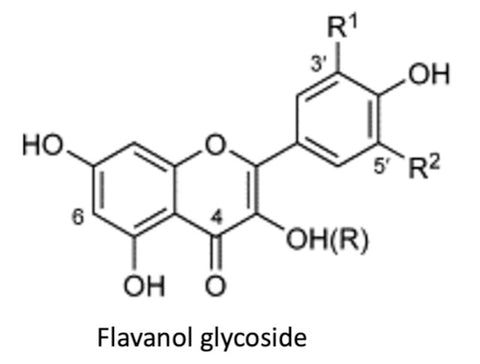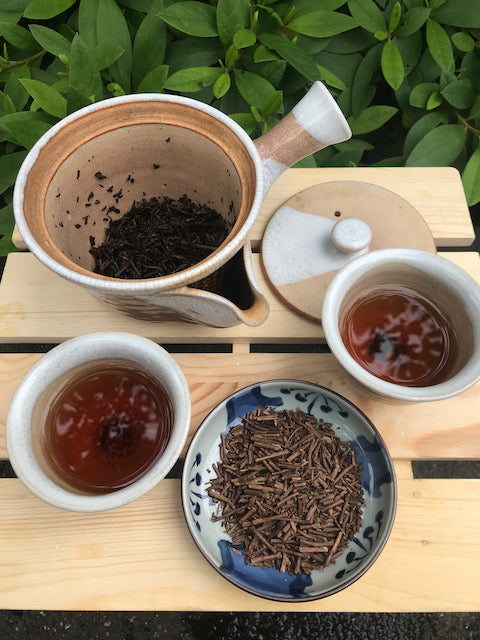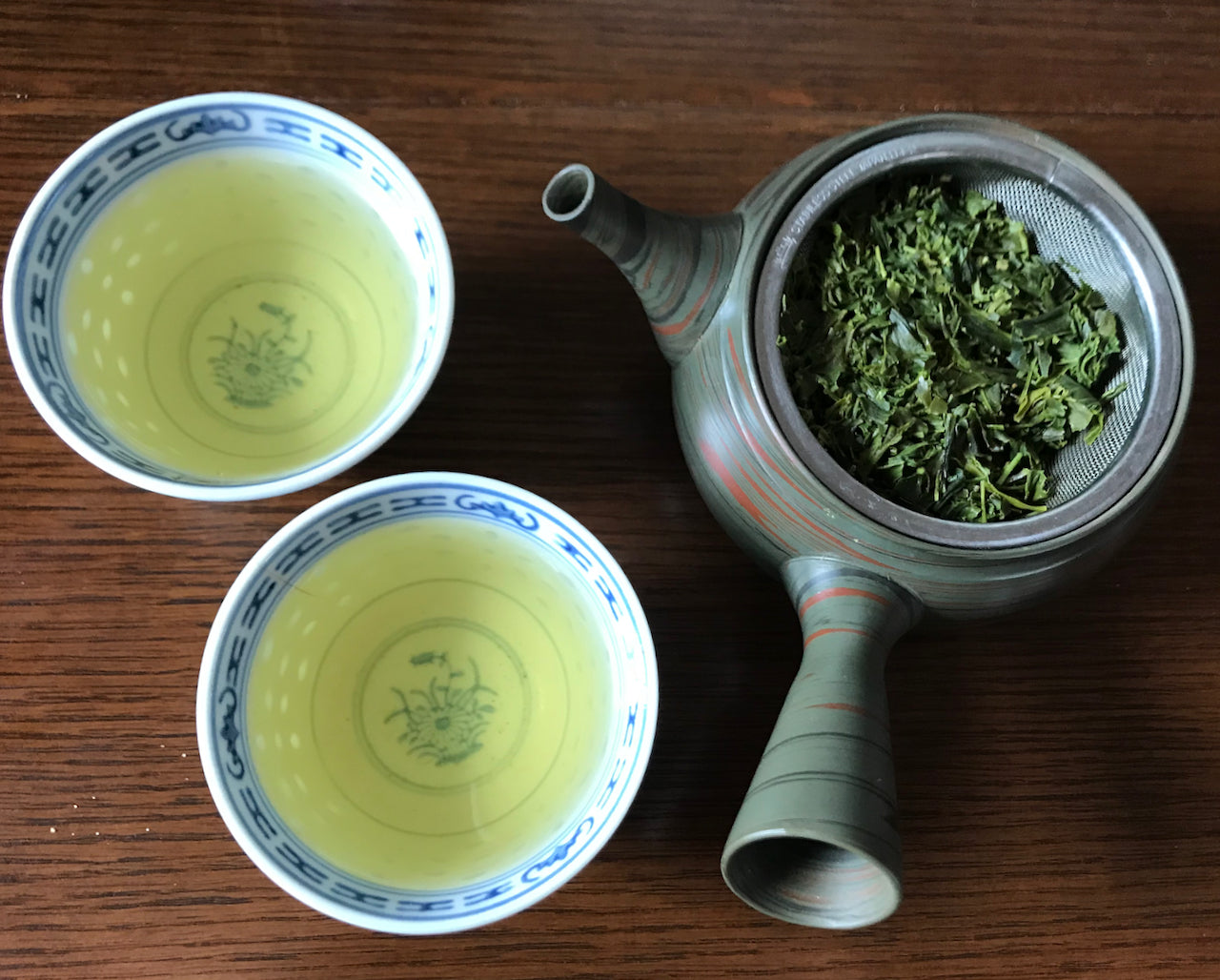This blogpost was written by guest writer Jimmy Burridge, PhD in Plant Science and tea aficionado. Photos are also from Jimmy. Enjoy!
Introduction
The color of a tea infusion strongly influences our impression of the quality of the tea and is closely judged in competitions. The subtle differences can actually be attributed to quite complex chemistry. The color of a tea infusion is primarily determined by the relative quantities of particular components that the plants make, called secondary metabolites, and then how these secondary metabolites change during subsequent processing, storage and finally steeping. We will explore a few elements within each of these categories.
 The pleasant light green of this sencha suggest a higher percentage of chlorophyll b and/or flavanol glycoside.
The pleasant light green of this sencha suggest a higher percentage of chlorophyll b and/or flavanol glycoside.
Chemistry
As discussed in a previous post, the chemistry behind tea flavor as well as color is a subject of intense scientific research and a lot of progress has been made in previous two decades thanks to new instruments and techniques (Shi et al., 2021). Polyphenols, the most common type of secondary metabolite in tea, have a big role in determining infusion color (Li et al., 2021). Flavonoids and catechins are categories of polyphenols and there are in turn many classes of both flavonoids and catechins (Wang et al., 2004).
Basically, different types of secondary metabolites have different solubilities and different degrees of astringency, so their relative concentration in the leaf and interaction with water temperature and steeping time can influence infusion color (Liu and Tzen, 2022). Among the many types of flavonoids are flavones, flavonols, flavanones, flavanols and anthocyanins (Shi et al., 2021). Among these is a version called flavanol glycosides, which have a glucose attached and contribute a yellowish color and a smooth or velvety mouthfeel (Liu and Tzen, 2022). Another phenolic compound, called quercetin, is major contributor of greenness to the final tea infusion (Wang et al., 2004).

The chemical structure of a typical flavanol glycoside. What is attached at R1 and R2 determines flavanol glycoside identity. For example, with an OH at R1 and a H at R2 the molecule becomes quercetin.
Growth conditions
Leaf color, size and thickness, as well as the relative quantity of the many types of plant secondary metabolites are influenced by abiotic (temperature, sunlight, soil water availability, soil fertility) and biotic (insect feeding, soil microbiome) factors. Healthy plants tend to have a darker shade of leaf. Shading and fertilization contribute to higher chlorophyll and amino acid content in the leaf. The quantity of chlorophyll, a pigment that makes plants green, obviously contributes to tea leaf color, as does the relative quantity of chlorophyll-a and b, with the b variety being slightly yellower. However, while bits of leaf and chlorophyll containing chloroplast do get into the infusion, chlorophyll itself is not actually water soluble and the color of the made tea is influenced by many more things than the color of the tea leaves!
Processing
Withering
In general, the color differences between broad tea types (black, oolong, green) is due to different enzymatic activity. Enzymatic reactions involving the many types of compounds in tea leaves transform one compound to another. Some green tea producers, particularly kamarichas allow a short withering stage, which can add some interesting depth. However, in typical green tea production enzymatic activity is stopped as early as possible, preserving the vibrant green color and expressing the essence of the living tea leaf.
Temperature
The temperature at which leaves are steamed or roasted, as well as the temperature and duration of the final drying phase can influence the chemical composition in the final product. Catechins are perhaps the most important class of chemicals that are influenced by high temperature and it is reported that epimerization and thermal degradation are the main influences on catechin transformation (Donlao and Ogawa, 2019).

Roasting sannen bancha over wood charcoal gives a particular aroma to the tea but the brown color is probably indistinguishable from other roasting methods. On the left is a hojicha latte and hojicha ice cream at a cafe in Uji. On the right is an old-school wood fired sannen bancha roaster in Isa, Kagoshima.
Mechanical forces; kneading, rolling
Even after the first step of steaming or pan-frying stops enzymatic activity, some chemical changes can take place. For example, the degree of bruising, breaking and cutting of leaves and/or their vacuoles can affect how chemicals in different parts of the leaf interact with each other and with oxygen from the air. The underlying reason for the burning eye sensation when chopping onions, as well as the difference in quality between chopping vs smashing garlic is due to the release of chemicals from ruptured vacuoles.
While mechanical kneading and rolling machines are designed to approximate the many hours of human labor required to hand process each kilogram of fresh tea, there is no denying that the visual appearance of hand rolled and harvested tea is very different from machine harvested and processed. Hand-picked and rolled leaves have a more uniform, almost needle like shape. Research shows impressive differences in morphology and microstructure of leaves as the tea goes through the different stages of mechanical processing (Qin et al., 2022). While the morphological and microstructure of hand processed versus machine processed leaves does not appear to have been much studied, one could imagine there are significant differences.
 Left, a rolling machine that (relatively) lightly compresses the tea as it rotates around the table. Right, a rake-like rotating machine that mimics a human picking up and dropping the tea. See also this post on hand rolling and a this video from award winning hand roller Akane Kawaguchi of Koukien Tea Garden.
Left, a rolling machine that (relatively) lightly compresses the tea as it rotates around the table. Right, a rake-like rotating machine that mimics a human picking up and dropping the tea. See also this post on hand rolling and a this video from award winning hand roller Akane Kawaguchi of Koukien Tea Garden.
Chopping, sifting
Leaf thickness, how finely the leaves have been chopped and the degree to which the final product has been sifted to a uniform size influence how quickly and completely particular compounds can be released into the infusion. The amount of fine particles in the tea can contribute color and/or continue to steep in the cup. The relative amount of veins and stems in the final product can also influence the sensory attributes and color of the infusion. However, a perfectly uniform product is not necessarily the best product. It is more the appropriate balance of components, preparation and processing that is important, and all of this comprise the skill of the tea master. Furthermore, there are genera of tea that quite deliberately include stems to contribute desired woodiness or to make the final infusion milder.

This Kuki hojicha from Zenkouen Tea Garden is 100% stem and has a marvelous roasted flavor, almost like a chicory coffee. We sometimes drink it after matcha or with rich desserts.
Side note: oxidized teas
Oxidized, sometimes known as fermented teas, such as black and oolong teas, have much more complex chemistry than green teas, in which steaming or pan frying stops enzymatic activity. It is thanks to this plethora of chemical reactions that fermented teas can offer a great variety of subtle taste and color differences. In case you haven’t heard, Japanese Black Tea, known as wakocha is one of the newest and most exciting genera of tea. Modern wakocha production emerged a little over 10 years ago and by now there are more than a handful of producers who have found excellent combinations of cultivar, fermentation and processing. The Meiji era history of Japanese black tea may be the subject of a subsequent post but it has to do with international competition (this previous post alludes to that competition).

After cultivar and growth conditions, withering and fermentation is the next stage of black tea production where a tea producer can interact with their tea. Fermentation is a passive process that usually takes place in large baskets or bins. Following fermentation leaves are typically chopped or bruised to allow chemicals in vacuoles to interact and to accelerate oxidation. While large scale producers of black tea in mainland Asia make use of sophisticated equipment to standardize the process, Wakocha remains an artisanal product, largely dependent on the experience and skill of the producer. The time and temperature of the fermentation step play a large role in the chemical reactions that convert catechins to a variety of other color and flavor influencing compounds.

Enjoying some wakocha with award winning tea producer Kajihara-san at his home in Ashikita, Kumamoto Prefecture.
Catechins are a very broad category of plant polyphenols and constitute a large percentage of the tea’s dry weight. Fermentation reduces catechin content, with some of them being broken down into smaller forms. Another portion is converted into larger and more complex forms, a process called polymerization. Two of the most important color influencing classes of chemicals in black tea are the result of polymerization of catechins, called theaflavins and thearubigins. They have red-orange and red-brown colors, respectively. These chemicals both increase in quantity as the tea ferments, but at a certain point theaflavins reach a maximum and then begin to decline. The ratio of theaflavins to thearubigins contributes to the color, mouthfeel and quality of the finished tea (Preedy, 2013). There are several types of both theaflavins and thearubigins as well as their derivatives, stereoisomers and a number of additional polyphenols that can contribute to flavor and color in black tea.

The chemical structure two types of theaflavin and a thearubigin.
Storage
Chemical changes over time are sensitive to temperature, exposure to oxygen and humidity. Studies have shown that storage temperature and duration influence sensory qualities and color of tea. Tea stored at -80°C and -20°C, temperatures that few non-researchers have access to, were able keep tea stored for 100 days chemically indistinguishable, as well as indistinguishable by human testers, from fresh tea (Dai et al., 2019). At a minimum, it is advisable to keep your tea in a cool dark place. However, not all changes are bad. In fact, several types of tea are defined by their aging process, such as three-year aged sannen bancha and some types of black tea. Optimizing this process is akin to an art, as so many variables, processes and their interactions are involved.
Steeping
The many different compounds in a tea leaf have different water solubilities, meaning they are released into the infusion at different rates and quantities, depending on water temperature and steep time. The second steep of a tea tends to have a different color, flavor and aroma precisely because many of the sensory compounds are highly water soluble and are thus released in the first steep. As you may have noticed, steeping some teas at a high temperature brings out bitterness. The bitter taste is primarily due to catechins, which come out much more readily at high temperature. Also, as you may have experienced, cold brewing tea results in a smooth, mellow, tea with more umami, in part because amino acids are more soluble than catechins. For this same reason cold brewing results in a lighter colored infusion (Lin et al., 2014).
Water chemistry, particularly pH and the amount of dissolved minerals in the water influence the chemical reactions happening as the tea steeps. Higher pH and greater amount of dissolved minerals contributes to faster oxidation and polymerization of catechins and a darker color (Cao et al., 2021). The importance of water has been recognized since the very early days of Japanese tea. Water was so important for the tea ceremonies of famed Shogun Toyotomi Hideyoshi (mentioned in a previous post) that he employed a specific family of tea masters to draw water from the middle of the Ujibashi bridge over the Uji river in Uji city,

There are reports that the material of the tea pot influences the chemical composition of the resultant tea infusion, oolong tea in the case of this study (Liao et al., 2018), although a direct connection to color was not reported. Incidentally, there is a lot of research on tea color in bottled tea production, as they want to stabilize the color. You may have even seen a cup of prepared tea that you let sit out change color after several hours. This change in color is due to oxidation. While the rapid steeping time of most green teas limits exposure to oxygen and thus reaction with oxygen, limiting oxidation reactions could be part of the reason teas with a longer steep time are frequently recommended with specific types and shapes of tea pots.
Conclusion
Flavonoids and catechins, such as quercetin and flavanol glycosides are the primary compounds contributing color in green tea. For black tea, catechin transformation to thearubigins and theaflavins is particularly important. Science has identified many specific plant secondary metabolites contributing to color but we don’t really understand how exactly environment and processing contributes to a ‘good’ color. Part of the reason is that we have different expectations of what a ‘good’ color is for different types of tea.
Beyond the chemistry of the tea leaves, as determined by cultivar, growth and processing, using fresh tea leaves that have been properly stored is probably the biggest factor in tea color. Finally, steep time and temperature can strongly influence color. To detect the influence of water chemistry and tea pot style you’d probably have to have side by side comparisons, which could be fun!
References
Cao, Q. Q., Wang, F., Wang, J. Q., Chen, J. X., Yin, J. F., Li, L., et al. (2021). Effects of brewing water on the sensory attributes and physicochemical properties of tea infusions. Food Chem. 364, 130235. doi:10.1016/j.foodchem.2021.130235.
Dai, Q., Liu, S., Jiang, Y., Gao, J., Jin, H., Zhang, Y., et al. (2019). Recommended storage temperature for green tea based on sensory quality. J. Food Sci. Technol. 56, 4333–4348. doi:10.1007/s13197-019-03902-7.
Donlao, N., and Ogawa, Y. (2019). The influence of processing conditions on catechin, caffeine and chlorophyll contents of green tea (Camelia sinensis) leaves and infusions. LWT - Food Sci. Technol. 116, 108567. doi:10.1016/j.lwt.2019.108567.
Li, J., Ma, J., Li, Q., Fan, S., Fan, L., Ma, H., et al. (2021). Determination of 35 Free Amino Acids in Tea Using Ultra-Performance Liquid Chromatography Coupled With Quadrupole Time-of-Flight Mass Spectrometry. Front. Nutr. 8. doi:10.3389/fnut.2021.767801.
Liao, Z. H., Chen, Y. J., Tzen, J. T. C., Kuo, P. C., Lee, M. R., Mai, F. Der, et al. (2018). Effect of teapot materials on the chemical composition of oolong tea infusions. J. Sci. Food Agric. 98, 751–757. doi:10.1002/jsfa.8522.
Lin, S. D., Yang, J. H., Hsieh, Y. J., Liu, E. H., and Mau, J. L. (2014). Effect of different brewing methods on quality of green tea. J. Food Process. Preserv. 38, 1234–1243. doi:10.1111/jfpp.12084.
Liu, C. T., and Tzen, J. T. C. (2022). Exploring The Relative Astringency of Tea Catechins and Distinct Astringent Sensation of Catechins and Flavonol Glycosides via an In Vitro Assay Composed of Artificial Oil Bodies. Molecules 27. doi:10.3390/molecules27175679.
Preedy, V. R. (2013). Tea in Health and Disease Prevention. Elsevier doi:10.1016/C2010-0-64948-0.
Qin, W., Yamada, R., Araki, T., and Ogawa, Y. (2022). Changes in Morphological and Functional Characteristics of Tea Leaves During Japanese Green Tea (Sencha) Manufacturing Process. Food Bioprocess Technol. 15, 82–91. doi:10.1007/s11947-021-02735-7.
Shi, J., Yang, G., You, Q., Sun, S., Chen, R., Lin, Z., et al. (2021). Updates on the chemistry, processing characteristics, and utilization of tea flavonoids in last two decades (2001-2021). Crit. Rev. Food Sci. Nutr. 0, 1–28. doi:10.1080/10408398.2021.2007353.
Wang, L.-F., Park, S.-C., Chung, J.-O., Baik, J.-H., and Park, S.-K. (2004). The Compounds Contributing to the Greenness of Green Tea. J. Food Sci. 69, 301–305. doi:10.1111/j.1365-2621.2004.tb09894.x.



